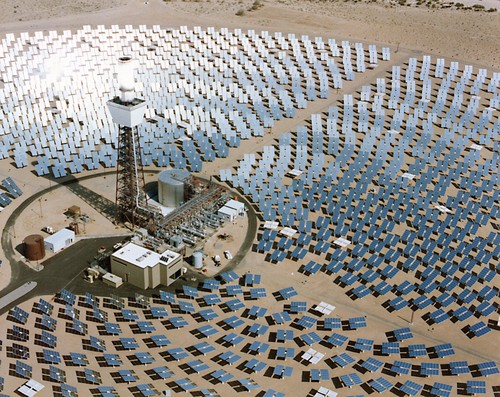By David Danelski, Jan 20
An environmental group has filed a lawsuit contending the federal government's "fast track" approval of a solar energy development -- already under construction in northeast San Bernardino County -- violated several laws.
The Western Watersheds Project, which works to protect watershed areas in six western states, wants a federal court to rescind the approvals and halt construction.
The complaint, filed Friday, names as defendants the U.S. Bureau of Land Management, the U.S. Fish and Wildlife Service, Interior Secretary Ken Salazar and other federal officials.
BrightSource Energy Co. broke ground in October on the 5.6-square-mile solar field in the Ivanpah Valley off Interstate 15 near Primm, Nev. The project was approved in an expedited process intended to help energy developers meet federal deadlines to qualify for stimulus subsidies.
BrightSource, based in Oakland, plans to focus heat from thousands of mirrors onto three "power towers" to generate steam and run turbines that would produce enough electricity for as many as 140,000 homes. The project is on public land controlled by the BLM.
"This project was just rushed," said Michael Connor, California director for Western Watersheds Project. "It was a rush to judgment. They had already decided they were going to build these things."
Lois Grunwald, a Ventura-based Fish and Wildlife spokeswoman, said she had not seen the complaint and could not comment on it. BLM officials also had no comment, spokesman David Briery said.
A BrightSource spokesman said in an e-mail that the company "does not comment on legal matters pertaining to governing bodies that regulate our industry."
The watershed group says the federal agencies cut corners on environmental reviews, violating the National Environment Policy Act and the Endangered Species Act, among other laws.
Among several allegations, the group accuses the government of inadequate reviews of alternatives, such as allowing BrightSource to build on nearby Ivanpah Dry Lake, which has little or no habitat value for desert tortoises, a species threatened with extinction, and other wildlife. The lawsuit says 30 tortoises have been found at BrightSource's current location.
The government also did not fully analyze how upgrading power lines will affect wildlife, the suit alleges.
The Western Watersheds lawsuit is one of several legal challenges to solar projects that the Obama administration approved last year on public land in the Mojave Desert.
The Sierra Club on Dec. 30 sued the California Energy Commission over its approval last fall of the Calico solar development, planned off Interstate 40 about 37 miles east of Barstow, said Gloria Smith, an attorney for the club. The suit, filed with the California Supreme Court, faults the commission for not detailing how the developer would compensate for lost wildlife habitat.
Also in December, a Native American cultural protection group and tribal members sued the Obama administration over the fast-track approvals of six large solar developments, including Ivanpah and Calico. They contend federal officials violated laws that protect sacred places.

